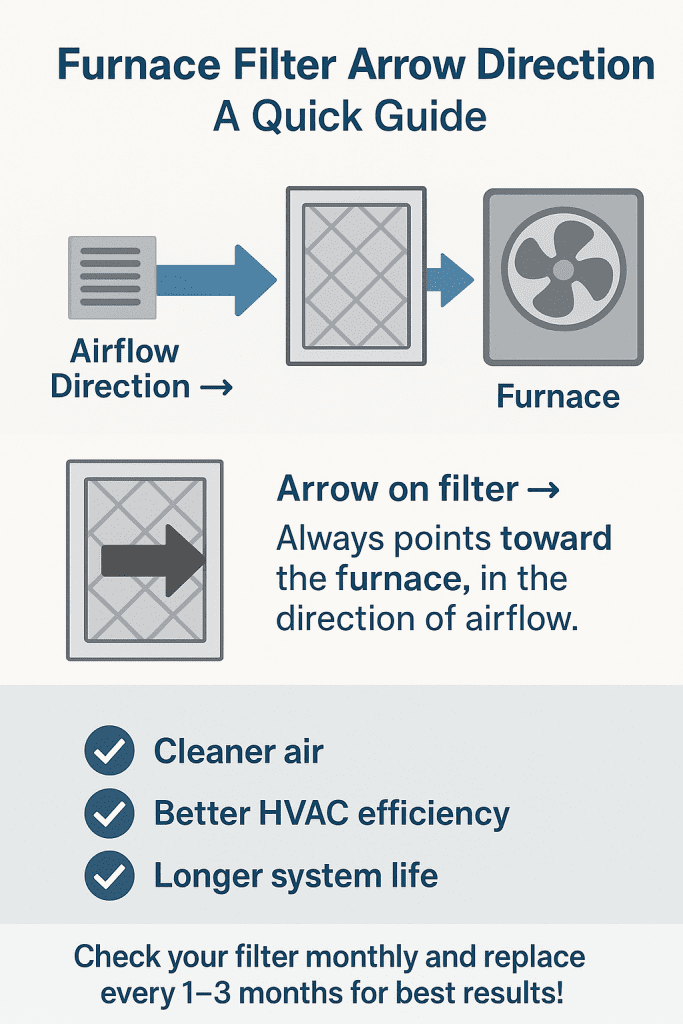Understanding Furnace Filter Arrow Direction: Why It Matters
If you’ve ever changed your furnace filter, you might have noticed an arrow printed on the frame of the filter. While it may seem like a small detail, paying attention to that arrow is actually very important for the efficiency and longevity of your HVAC system.
What the Arrow Means
The arrow on a furnace filter indicates the direction of airflow. In other words, it shows which way the air is moving through your system. Your furnace or air handler pulls air from your home through the return vents and pushes it through the filter before circulating it back into your living space.
How to Install Your Filter Correctly
-
Locate the airflow direction – Most HVAC systems have an arrow or label near the filter slot showing which way the air travels. Typically, air moves from the return duct toward the blower motor.
-
Match the arrow to airflow – When inserting a new filter, the arrow on the filter frame should point in the same direction as the airflow. Usually, this means the arrow points toward the furnace or air handler, not toward your living space.
-
Double-check fit – Make sure the filter sits snugly in its slot with no gaps around the edges. A proper fit prevents unfiltered air from bypassing the filter.

Why Direction Matters
Installing a furnace filter backward can reduce its effectiveness and put extra strain on your system. Here’s why:
- Reduced airflow – A filter installed against the airflow can restrict air movement, forcing your furnace or air conditioner to work harder and use more energy.
- Poor filtration – Dust, pollen, and debris can pass through more easily if the filter is backwards, leading to dirtier ducts and indoor air.
- Potential damage – Over time, restricted airflow can cause your system to overheat or even damage the blower motor.
Tips for Maintaining Your Filter
- Check monthly – Depending on usage and filter type, check your furnace filter every month and replace it every 1 – 4 months.
- Use the right filter – Always choose a filter that fits your system and meets the manufacturer’s recommended MERV rating.
- Keep the area clean – Make sure the area around your furnace is free of dust and debris to help your filter last longer.
Read more: How often to change filter
Why the Highest-Rated Filters Aren’t Always the Best Choice
It might seem logical to assume that the higher the MERV rating on a filter, the better it is for your home, but that’s not always the case. Filters with very high MERV ratings (such as 13–16) are designed to capture extremely small particles, including pollen, dust mites, and even bacteria. While this sounds ideal, these filters can also restrict airflow more than lower-rated filters.
Not all HVAC systems are built to handle this reduced airflow. Using a filter that’s too dense for your system can make your furnace or air conditioner work harder, potentially shortening its lifespan, reducing efficiency, and even causing uneven heating or cooling in your home.
For many residential systems, a mid-range MERV rating (around 8–11) provides a balance: it effectively captures dust, pet dander, and other common allergens while allowing your system to operate efficiently. Always check your system manufacturer’s recommendations before upgrading to a higher-rated filter.
READ MORE: Do the furnace and AC use the same filter?
Bottom Line
The arrow on your furnace filter isn’t just decorative – it’s a guide to proper installation. By following the direction of airflow and replacing your filter regularly, you’ll keep your HVAC system running efficiently, prolong its lifespan, and maintain cleaner indoor air.

